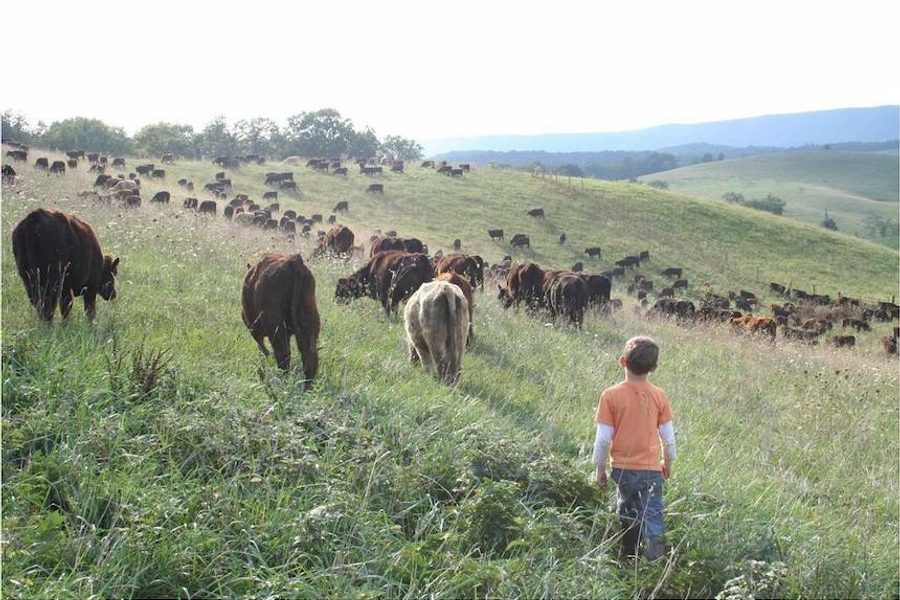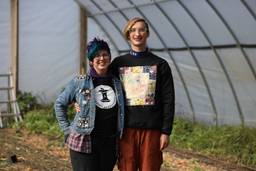
Polyfaces—a documentary directed by Lisa Heenan and Isaebella Doherty — goes deep behind the scenes of Polyface Farm, a celebrated family-run operation located in Virginia’s Shenandoah Valley. The film explores Polyface’s unique back-to-basics farming techniques and gives a colorful look at Joel Salatin and his family as they lead the effort toward sustainable farming and slow food.
Prizing transparency, environmentally friendly practices and the production of chemical-free, “clean” meat and eggs, Polyface offers a striking alternative to the prevailing model of industrialized crop farming and corporate agribusiness. Salatin has been named the “most innovative farmer in the world” by TIME magazine, and was featured in Michael Pollan’s best-seller The Omnivore’s Dilemma and the 2008 documentary Food, Inc.
Currently, less than 10 percent of the nation’s 2.1 million farmers have transition plans to pass their land and business to the next generation, and much has been made of the looming crisis of America’s aging farmer. But at Polyface Farm, Sheri Salatin, daughter-in-law of Joel Salatin and marketing director at the farm, has seen firsthand the growing interest in sustainable farming from the youngest generations. So in July 2014, she launched Eager Farmer — an online resource specifically meant to bridge the generational divide and give American agriculture a new way forward.
The following interview has been slightly edited.
Jessica Wang: Talk about the Eager Farmer program — what motivated you to start it?
Sheri Salatin: One of the things that we do at Polyface is teach young — and I say young farmers, but I mean inexperienced farmers — how to do this kind of farming and make a living at it. And we’d gotten to the point where our internship program had become quite popular. But it was to the point that we were getting 260 applications for eight spots. Well, my heart literally, as a mom, was breaking for all of these young farmers that we were sending away. And it’s not as if they’re not amazing, it’s because there wasn’t enough place for them. How can you possibly teach 260 students? On the flip side, we would have these older farmers coming in who had experience, and say, “My children aren’t interested in farming, and I want to do it the right way, and I just can’t find anybody.”
And so that’s how Eager Farmer came to be: my passion for getting these young people hooked up with mentors, helping landowners who don’t want to farm to find farm managers, or people who have experience farming but no land to get matched up… and then really answer the question of the aging farmer. That’s the big question right now. The average farmer is 70 years old — what’s going to happen to all the farmland? Where will our food come from?
An estimated 400 million acres of farmland in America is going to change hands in the next 20 years. You’ve been trying to figure out how to put a new generation of farmers on the land. What have been the biggest obstacles?
First, I think that the interest is huge. I think the millennial generation wants to make a difference, and they also want to be noticed. And they’re really getting into this idea of clean food. They’re the first generation we’ve had in a really long time that is being taught that our natural resources in the world are not going to last forever. So they’re becoming more and more conscious of the environment and conscious of what they eat and how it’s raised.
The big hurdles are connecting both generations and finding the right fit. The thing with some millennials, though of course not all of them, is that many of them are not willing to put in the hard work. They’re not willing to stick it out. Farming is drudgery on certain days — there will be days that nobody notices you. And there are some days where it flat-out stinks to be a farmer. So I think some of it will have to be a shift for them — to realize they’re going to find that inner strength to push and keep at it and be strong. But there’s also that older generation that’s going to have to allow this younger generation to get in and allow for their farm to look different than they thought it would. Allow the tractors to be used in a different way. In many of the events we hold at the farm, we see the bridge of those two generations coming together.
What does this new generation of eager farmers look like? I imagine most people have this stereotypical image in their head of a young person that’s part hippie, part environmental activist.
Oh my goodness, it’s insane how diverse they are. Today’s the first day we’re open for applications for interns. Here’s a quick gander at the people involved: I’ve got a father with two young children, ex-military, who wants to start something new. I’ve got a young person who just turned 18, home-schooled his whole life. I’ve got a young lady has been around the world with the Peace Corps [who is] super interested in settling down and doing something different. I’ve got another lady who’s sick of the rat race in corporate America — she’s been sitting at a desk her whole life. This is just today. We have people from all kinds of walks of life and all kinds of demographics and interests.
From what you’ve seen and heard, what is drawing these young people to farming?
The way that Polyface does farming is attracting the best and brightest, because it’s more of an intellectual thing. It marries the brawn with the brain. You have to be smart. And I’m not saying farmers are dumb, but in the past we’ve had this idea where ‘if they can’t do anything else, let them farm’. But now, because of the competition that’s out there — because of the market, because of all these things — if you’re wanting to really carry your product all the way through (and not just do the production side, but do the processing, distributing, marketing — all four legs of it) you’ve got to really have the savvy to compete and to be good enough to compete against the big guys. Because that’s who we’re competing against.
Geographically, where have you seen the most interest?
Right now, it’s really the outer areas of the country. I have not seen much break into our middle crop belt — Kansas, Nebraska, Missouri, Iowa. But we’ve seen lots in Florida, New York, California, Oregon, Washington, even Montana, and Colorado — but nothing in the real core center yet. I think it’s just harder because everything is already plowed up.
What’s been most rewarding for you with your work at Polyface and Eager Farmer?
The thing that I find most rewarding is seeing people realizing their dreams. And whether that is finding food that saves the life of their child, or finding something that makes them so healthy that they’re then able to do all the things they always wanted to do. Or it’s a young person finding their niche in the world — seeing what really makes them happy and fulfilled. Or it’s an older person being able to transfer their passion for what they do, and see that shine out through the next generation. That makes me get up in the morning.
Any specific stories that have stuck with you?
Not maybe a month ago, I had a lady email me to tell me that her son has had severe allergies to the point where he almost had nothing to eat. Horrible — you cannot imagine. But she was writing to tell me that the broth that she makes from our chicken and our beef is saving his life. Because of the nutrients in it, and the lack of chemicals, and the purity in those products that we raised for her is giving him health. And she said she was so excited, because it looked like for the first time in a very long time, he was finally going to be able to eat some of our chicken. He’d been on our broth diet for a year and had been progressing. Things like that, how could you not be excited?
Industrial agriculture still dominates the farming landscape — we’re talking large-scale commodity crops, heavy use of chemical fertilizers and pesticides, and meat production in confined animal feeding operations. What’s the good news out there in sustainable farming?
I think it’s really exciting to see a growing number of families returning to the farm. And in the return to the family farm, it is also bringing back communities, and responsibility and going back to the dinner table. My hope is that the generation of disconnectedness with our social media and computers and all of that will gradually start turning back around to balance itself. We’ve swung so far, I’m hoping as the pendulum swings back to the center — that we’ll find that perfect balance of being able to stay in touch with people around the world and continue the relationship with a friend that moved away or whatnot, but also have real-time, real-life, person-to-person relationships. And with Eager Farmer, I’m excited about seeing some postings that have been outside of just farming. And that’s where we’re all going to be able to be involved in this. Because we need photographers, we need website designers, we need bookkeepers, we need all of it.
(“A New Way Forward for American Agriculture” was originally posted on BillMoyers.com and is reposted on Rural America In These Times with permission. You can follow the author of this interview on Twitter @j_k_wang.)




